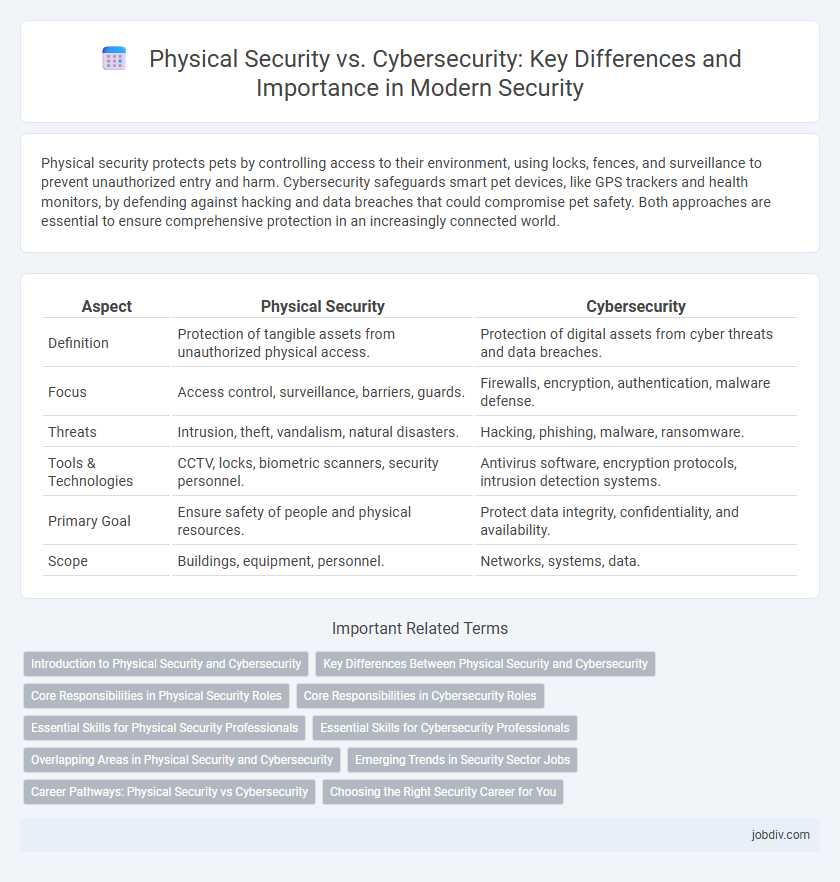Physical security protects pets by controlling access to their environment, using locks, fences, and surveillance to prevent unauthorized entry and harm. Cybersecurity safeguards smart pet devices, like GPS trackers and health monitors, by defending against hacking and data breaches that could compromise pet safety. Both approaches are essential to ensure comprehensive protection in an increasingly connected world.
Table of Comparison
| Aspect | Physical Security | Cybersecurity |
|---|---|---|
| Definition | Protection of tangible assets from unauthorized physical access. | Protection of digital assets from cyber threats and data breaches. |
| Focus | Access control, surveillance, barriers, guards. | Firewalls, encryption, authentication, malware defense. |
| Threats | Intrusion, theft, vandalism, natural disasters. | Hacking, phishing, malware, ransomware. |
| Tools & Technologies | CCTV, locks, biometric scanners, security personnel. | Antivirus software, encryption protocols, intrusion detection systems. |
| Primary Goal | Ensure safety of people and physical resources. | Protect data integrity, confidentiality, and availability. |
| Scope | Buildings, equipment, personnel. | Networks, systems, data. |
Introduction to Physical Security and Cybersecurity
Physical security involves protecting tangible assets such as buildings, equipment, and personnel from unauthorized access, damage, or theft through measures like surveillance cameras, access control systems, and security personnel. Cybersecurity focuses on safeguarding digital information, networks, and systems from cyber threats including hacking, malware, and data breaches using firewalls, encryption, and intrusion detection systems. Both disciplines aim to create comprehensive protection frameworks that mitigate risks to organizational resources in an increasingly interconnected environment.
Key Differences Between Physical Security and Cybersecurity
Physical security involves protecting tangible assets such as buildings, equipment, and personnel from physical threats like theft, vandalism, or natural disasters, while cybersecurity focuses on safeguarding digital information systems and networks against cyberattacks like hacking, malware, and phishing. Physical security relies on measures like access controls, surveillance cameras, and security guards, whereas cybersecurity uses firewalls, encryption, and intrusion detection systems to prevent unauthorized digital access. The key difference lies in the nature of threats addressed: physical security targets tangible, real-world risks, whereas cybersecurity defends against virtual, information-based threats.
Core Responsibilities in Physical Security Roles
Physical security roles prioritize safeguarding personnel, facilities, and tangible assets through controlled access, surveillance systems, and emergency response protocols. Core responsibilities include implementing perimeter security measures, managing security personnel, and conducting risk assessments to mitigate threats such as theft, vandalism, and unauthorized entry. Continuous monitoring and maintenance of security infrastructure enhance overall protection against physical breaches and ensure compliance with safety regulations.
Core Responsibilities in Cybersecurity Roles
Core responsibilities in cybersecurity roles encompass identifying, preventing, and mitigating cyber threats targeting digital assets and sensitive information. Professionals manage firewalls, intrusion detection systems, and encryption protocols to safeguard networks against unauthorized access and data breaches. Continuous monitoring, vulnerability assessments, and incident response ensure the integrity, confidentiality, and availability of critical information systems.
Essential Skills for Physical Security Professionals
Physical security professionals require skills in access control management, surveillance systems operation, and emergency response coordination to effectively protect assets and personnel. Proficiency in risk assessment, threat identification, and crisis management ensures timely mitigation of security breaches. Knowledge of building security infrastructure and regulatory compliance further enhances their capability to maintain a secure environment.
Essential Skills for Cybersecurity Professionals
Cybersecurity professionals require strong analytical skills to identify vulnerabilities and anticipate potential threats within complex digital environments. Mastery of programming languages, network security protocols, and threat detection tools is essential for preventing and mitigating cyberattacks. Understanding risk assessment and incident response strategies enables cybersecurity experts to protect organizational assets effectively.
Overlapping Areas in Physical Security and Cybersecurity
Physical security and cybersecurity intersect in areas such as access control, where biometric authentication and smart badges secure both physical entry points and digital systems. Surveillance technologies like CCTV integrated with network security help monitor and respond to unauthorized access or breaches in real-time. Incident response strategies often overlap, requiring coordinated efforts to manage risks affecting both physical assets and cyber infrastructure.
Emerging Trends in Security Sector Jobs
Emerging trends in security sector jobs reveal a rising demand for professionals skilled in both physical security and cybersecurity to address the convergence of digital and physical threats. Roles such as Security Analysts, Cybersecurity Specialists, and Integrated Security Consultants are evolving to include expertise in threat intelligence, biometric access control, and IoT security systems. The integration of AI-driven surveillance and advanced encryption methods underscores the need for hybrid skill sets that protect critical infrastructure against sophisticated attacks.
Career Pathways: Physical Security vs Cybersecurity
Career pathways in physical security often involve roles such as security officers, facility managers, and surveillance specialists, emphasizing on-site protection and risk management. Cybersecurity careers focus on roles like information security analysts, ethical hackers, and network security engineers, demanding expertise in threat detection, vulnerability assessment, and incident response. Both fields offer specialization opportunities, with physical security integrating access control systems and cybersecurity advancing in areas like cloud security and threat intelligence.
Choosing the Right Security Career for You
Choosing the right security career depends on your interests and skill set, with physical security focusing on protecting tangible assets and environments from unauthorized access, theft, or damage. Cybersecurity emphasizes safeguarding digital information, networks, and systems from cyber threats, requiring proficiency in encryption, threat analysis, and incident response. Assessing market demand, potential salary, and personal aptitude for either hands-on physical protection or technology-driven cyber defense guides a successful career path in the security field.
Physical Security vs Cybersecurity Infographic

 jobdiv.com
jobdiv.com